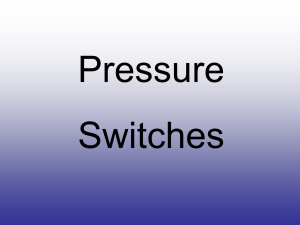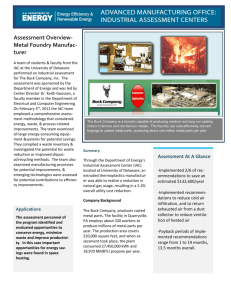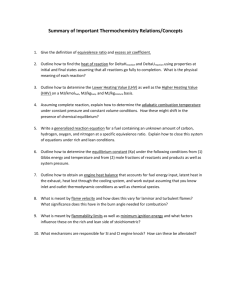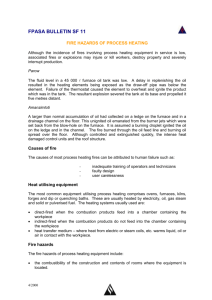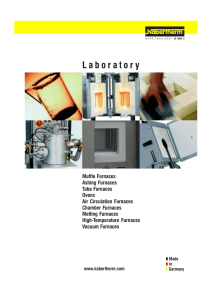JEFFERSON COLLEGE
advertisement
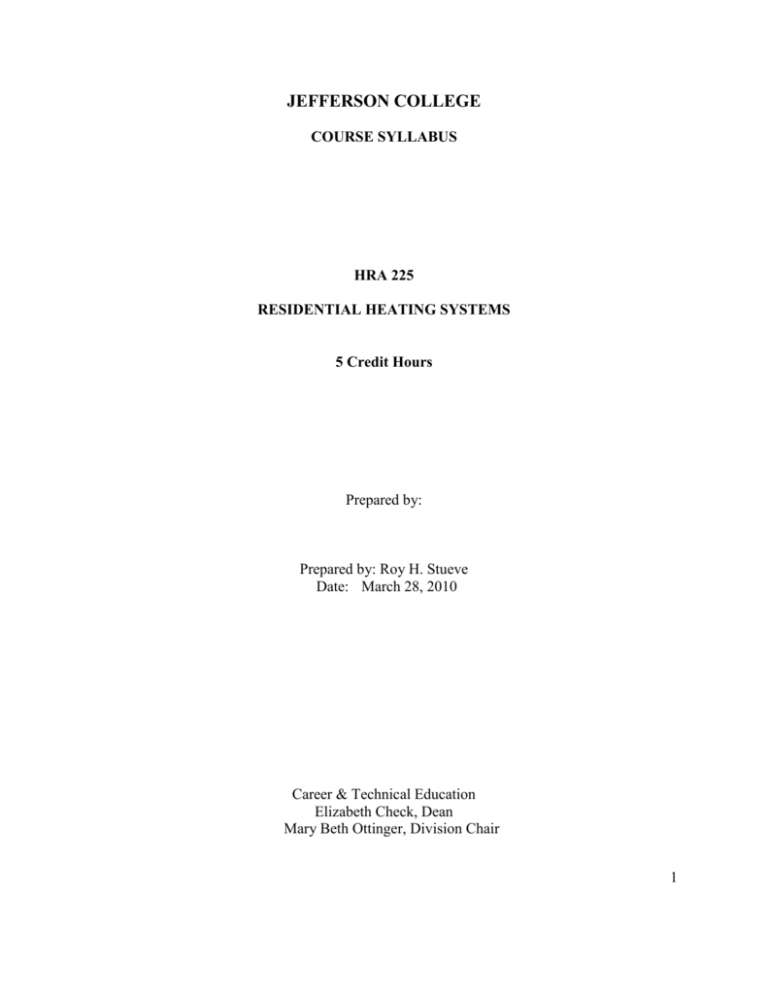
JEFFERSON COLLEGE COURSE SYLLABUS HRA 225 RESIDENTIAL HEATING SYSTEMS 5 Credit Hours Prepared by: Prepared by: Roy H. Stueve Date: March 28, 2010 Career & Technical Education Elizabeth Check, Dean Mary Beth Ottinger, Division Chair 1 HRA 122 I. RESIDENTIAL HEATING SYSTEMS CATALOG DESCRIPTION A. Prerequisite: HRA121, Refrigeration Mechanical Systems, HRA122, Air Conditioning Mechanical Systems. B. 5 semester credit hours C. Residential Heating Systems studies the theory, installation, diagnosis, and service of residential heating systems. This course covers high efficiency gas heating systems, oil systems, and electric heating systems. II. EXPECTED LEARNING OUTCOMES / ASSESSMENT MEASURE Students will be able to understand and check electric forced air heating systems. Students will understand electric heat functioning with heat pump system. Students will understand and wire gas furnaces and gas furnace controls. Students will be able to calculate ductwork sizes for residential heating and cooling equipment. Students will understand and be able to check gas furnace controls for high efficiency and standing pilot. Students will understand gas piping and pipe sizing. Students will understand fuel oil characteristics for oil furnaces. In-class exam as well as homework and/or quizzes, and/or in-class projects Students will understand and be able to service oil furnace electric systems and control systems. Students will understand and check oil furnace combustion efficiency. Students will understand and service gas fueled hydronic heating with electric wiring and control wiring. Students will understand and check indoor air quality. Students will check for air pollutants. (Same as above) (Same as above) (Same as above) (Same as above) (Same as above) (Same as above) (Same as above) (Same as above) 2 III. COURSE OUTLINE SECTION 6: AIR CONDITIONING (HEATING AND HUMIDIFICATION) Unit 30 Electric Heat 1. Introduction 2. Portable Electric Heating Devices 3. Radiant Heating Panels 4. Electric Baseboard Heating 5. Unit Heaters 6. Electric Hydronic Boilers 7. Central Forced-Air Electric Furnaces 8. Automatic Controls for Forced-Air Electric Furnaces 9. The Low-Voltage Thermostat 10. Controlling Multiple Stages 11. Wiring Diagrams 12. Control circuits for Forced-Air Electric Furnaces 13. Fan Motor Circuits 14. Contactors for Controlling Electric Furnaces 15. Airflow in Electric furnaces 16. Service Technician Calls Unit 31 Gas heat 1. 2. 3. 4. 5. 6. 7. 8. 9. 10. 11. 12. 13. 14. 15. 16. 17. 18. 19. 20. 21. 22. 23. Introduction to Gas-Fired, Forced-Hot-air Furnaces Types of Furnaces Gas Fuels Gas Combustion Gas Regulators Gas Valve Solenoid Valve Solenoid Valve Diaphragm Valve Heat Motor-Controlled Valve Automatic Combination Gas Valve Manifold Orifice Burners Heat Exchangers Fan Switch Limit Switch Pilots Safety Devices at the Standing Pilot Ignition systems Flame Rectification High-Efficiency Gas Furnaces Electronic Ignition Modules and Integrated Furnace Controllers Two-Stage Gas Furnaces 3 24. 25. 26. 27. 28. 29. 30. 31. Modulating Gas Furnaces Venting Gas Piping Gas Furnace Wiring Diagrams and Troubleshooting Flowcharts Troubleshooting the Safety Pilot-Proving Device – The Thermocouple Troubleshooting spark Ignition and Intermittent Pilot Systems Combustion Efficiency Service Technician Calls Unit 32 Oil Heat 1. 2. 3. 4. 5. 6. 7. 8. 9. 10. 11. 12. 13. 14. 15. 16. 17. 18. Introduction to Oil-Fired Forced-Warm Air Furnaces Physical Characteristics Fuel Oils Oil Storage Fuel Oil Supply Systems Combustion Preparation of Fuel Oil for Combustion By-Products of Combustion Gun-Type Oil Burners Oil Furnace Wiring Diagrams Stack Switch Safety Control Cad Cell Safety Control Combustion chamber Heat Exchanger Condensing Oil Furnace Service Procedures Combustion Efficiency Service Technician Calls Unit 33 Hydronic Heat 1. 2. 3. 4. 5. 6. 7. 8. 9. 10. Introduction to Hydronic Heating The Heat Source The Basic Hydronic system The Point of No Pressure Change Other Hydronic System Components High-Temperature Hydronic Piping systems Radiant, Low-Temperature Hydronic Piping systems Combination (High- and Low-Temperature) Piping Systems Tankless Domestic Hot Water Heaters Service Technician Calls Unit 34 Indoor Air Quality 1. 2. 3. 4. 5. 6. Introductions Sources of Indoor Air Pollution Controlling Indoor air Contamination Common Pollutants Contamination Source Detection and Elimination Ventilation 4 7. 8. 9. 10. 11. 12. IV. Air Cleaning Duct Cleaning Air Humidification Sizing Humidifiers Installation Service, Troubleshooting, and Preventive Maintenance METHOD OF INSTRUCTION A. Classroom Lecture B. Lab Demonstrations C. Specialty Lectures by Industry Personnel V. REQUIRED TEXTBOOK(S) Refrigeration and Air Conditioning Technology; 6th Edition; Whitman, Johnson, Tomczyk, Silberstein; Delmar Publications; ISBN: 1-4283-1936-0 VI. REQUIRED MATERIALS 1. Electronic calculator with scientific notation 2. Basic hand tools (as outlined on attached tool list) VII. SUPPLEMENTAL REFERENCES Modern Refrigerating and Air Conditioning; Althouse, Turnquist, Bracciano; 18th Edition; ISBN: 1-59070-280-8 VIII. METHOD OF EVALUATION A. Theory Tests, Quizzes, Homework B. Shop/Lab C. Instructor Evaluation, Attendance IX. 45% 45% 10% ADA STATEMENT Any student requiring special accommodations should inform the instructor and the Coordinator of Disability Support Services (Library; phone 636-797-3000, ext. 169). X. ACADEMIC HONESTY STATEMENT All students are responsible for complying with campus policies as stated in the Student Handbook (see College Website). 5 HEATING, REFRIGERATION AND AIR CONDITIONING HAND TOOL LIST All of the tools on the following list will be used in the first and second years of training. All tools and equipment should be marked for identification. Any used tools or similar equipment are acceptable provided they are safe to use and are adequate for the program. The tools marked with an * may be purchased through different suppliers at a student discount. ! ! ! ! ! ! ! ! ! ! ! ! ! ! ! ! ! ! ! ! ! ! ! ! ! ! ! ! ! Padlock with keys or combination lock Tool pouch with belt or small tool box VOM Fieldpiece SC76 Pump (multi-pliers) pliers – insulated handle only – 10” Screwdriver pocket size – square tip Screwdriver 6” blade – square tip – insulated handle only Screwdriver 6” blade – Phillips’ tip – insulated handle only or multi-bit or combination set Long-nose (needle-nose) pliers #6 – insulated handle only Slip-joint (wire pliers) pliers #6 – insulated handle only Diagonal (side cutters) pliers #6 – insulated handle only Protective (safety) glasses, clear glass w/side shields only (students must have and use safety glasses in the shop area at all times) Center punch Hammer ball bein 8 oz. (no claw hammer) * Allen Screw Wrench set #TL 16 or equal (must have 6” shafts) Nut Driver Set 3/16” to 1/2” (or socket set) 6-piece open-end wrench set 3/8” to 11/16” (or box-end wrench set) 8” adjustable wrench Steel-tape rule 6” Robinair gauge manifold set #40153 or equal 10” adjustable wrench Tool box with tray *Flaring tool set 3/16” to 5/8” *Tube cutter 3/16” to 5/8” *Swaging tool set 3/16”to 5/8” (5pc) *Tubing reamer #208F *Thermometer pocket -20° to 220° F (no glass) *Reversible ratchet wrench ¼”, 3/8”, 3/16”, 5/16” *Tubing cutter, small (Imp) TC1050 *Constrictor wheel #76637 6 SHOP WORK SCHEDULE All shop work assignments are in lab manual, Refrigeration & Air Condition Technology, Sixth Edition; Delmar Cengage Learning. Learning assignments in lab manual will follow scheduled theory lecture chapters. Chapter One in theory textbook, Refrigeration & Air Condition Technology by Bill Whitman, Bill Johnson, John Tomczyk, and Eugene Silberstein, will be Chapter One in lab manual, Refrigeration & Air Condition Technology. 7

